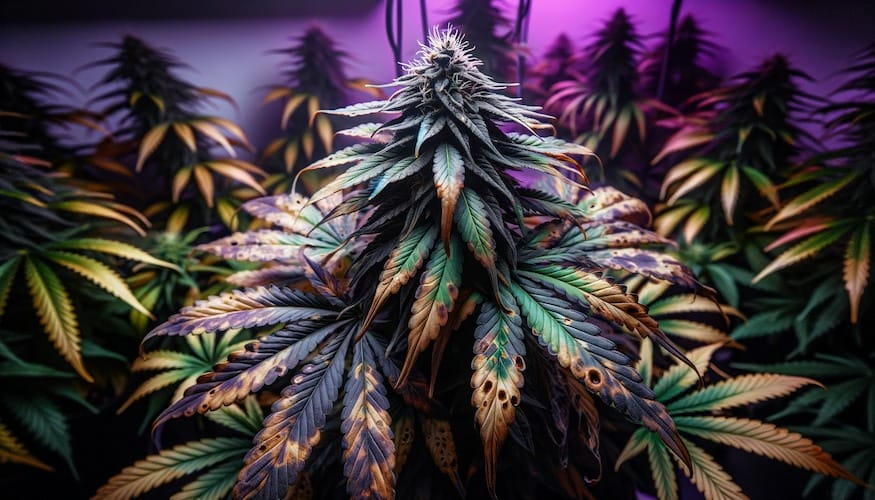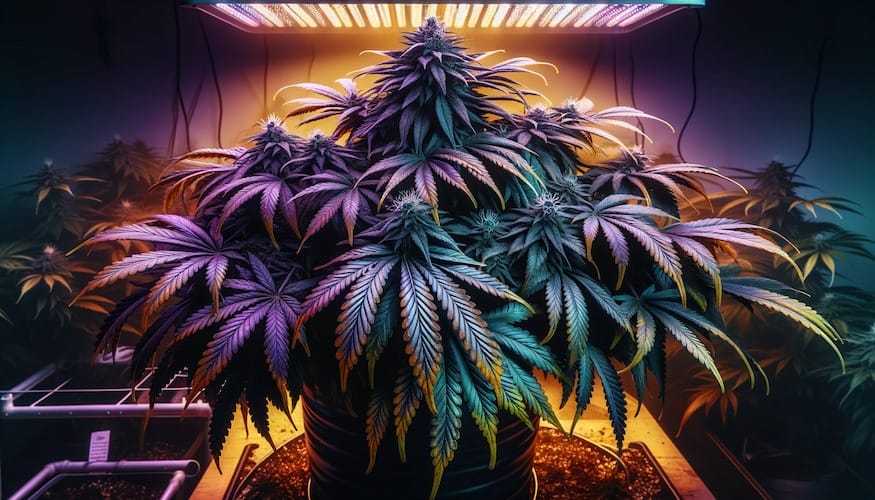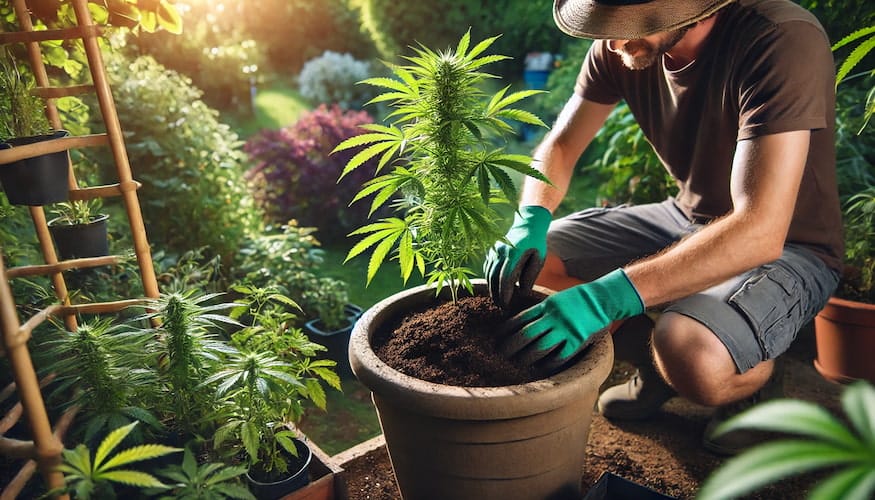The use of cannabis has evolved significantly over the years, with many people now turning to it for a variety of therapeutic and recreational purposes. One of the key considerations for users is the strain of cannabis they choose, as different cultivars can have vastly different effects. For daytime use, the ideal strains are those […]
Phosphorus Deficiency in Cannabis: Quick Solutions

Striving for vibrant cannabis growth is a hallmark of dedication for cultivators across the nation. Recognizing signs of phosphorus deficiency in cannabis plants can be the pivotal difference between merely good and truly great harvests. It’s an issue that stealthily creeps up, yet leaves a clear mark on cannabis health, affecting the verdancy of your plants and, eventually, your yield. If you’re noticing the lower leaves beginning to display a darker hue, or necrotic spots forming, it’s time to act. This quick guide offers solutions to help you restore and maintain the vitality of your cherished plants.
But worry not, there’s no need to navigate the world of cannabis nutrition alone. We present to you, not only the causes but also the remediation steps to manage phosphorus deficiency with confidence. Growers, it’s time to raise your plants with knowledge, care, and the reassurance that comes from understanding how to foster cannabis health at every stage.
Key Takeaways
- Identifying early signs of phosphorus deficiency is crucial for plant health and yield
- phosphorus is essential during the flowering stage for optimal bud formation
- Adjusting soil pH is a fundamental solution for aiding phosphorus absorption
- Maintaining proper nutrition through careful selection of fertilizers can prevent deficiencies
- Regular monitoring can ensure quick intervention and a return to vibrant cannabis growth
Understanding the Role of Phosphorus in Cannabis Cultivation
To realize the full potential of your cannabis plants, it’s essential to have a deep insight into one of the most critical components for their development: phosphorus. A guiding force behind healthy cannabis growth, phosphorus is more than just a nutrient; it’s a catalyst for key biological processes. Its impact is most pronounced in the energy transfer, and flower formation, which are crucial stages in the life cycle of a cannabis plant. In the pursuit of thriving crops, emphasizing the role of phosphorus in cannabis cannot be overstated.
The Importance of Macronutrients for Healthy Growth
Cannabis plants rely on a delicate balance of nutrients referred to as cannabis macronutrients: nitrogen (N), phosphorus (P), and potassium (K). Together, these form the bedrock of a cannabis plant’s diet, with each playing a unique role in fostering healthy cannabis growth. Phosphorus, in particular, is vital for the development of new tissue and assists in resistance to various plant diseases.
Phosphorus: A Key Player in Energy Transfer and Flower Formation
During photosynthesis and respiration, phosphorus is indispensable for the energy transfer within cannabis plants. Its presence influences adenosine triphosphate (ATP), which acts as an energy currency within the cells. Without it, plants struggle to manage the energy crucial for growth and survival. When it comes to reproductive success, the cannabis flower formation hinges on access to ample phosphorus, which ensures the production of bountiful and potent buds.
| Function | Role of Phosphorus |
|---|---|
| Energy Transfer | Crucial for ATP formation and overall energy management. |
| Root Development | Promotes strong root system for enhanced nutrient uptake. |
| Cell Division & DNA/RNA Synthesis | Supports genetic building blocks for plant development and vigor. |
| Flower Formation | Integral for bud development and its resulting yield quality. |
With a distinctly pivotal role to play, phosphorus is a cornerstone of successful cannabis cultivation. Nurturing plants with the right proportion of phosphorus ensures the energy is rightly allocated, the framework for growth is laid, and the rewards of cultivation are realized through high-quality yield. For cultivators, mastering the role of phosphorus in cannabis becomes a synonym for gardening success.
Identifying Symptoms of Phosphorus Deficiency in Cannabis
As a crucial nutrient for cannabis health, phosphorus plays a vital role in the plant’s overall vigor and productivity. Recognizing phosphorus deficiency early can mean the difference between a bountiful harvest and a compounding garden issue. Let’s explore the telltale cannabis leaf symptoms and track the progression of deficiency in cannabis plants.
Recognizing Early Signs on Older Leaves
Observing the state of your cannabis plants’ older leaves is essential when seeking to identify a phosphorus deficiency. Symptoms often manifest first on these leaves, revealing visual cues about the plant’s internal health. Discoloration is typically the initial sign, with leaves showing a shift towards dark green, blue, or greyish tones, sometimes accompanied by unnatural splotching patterns. This discoloration is indicative of phosphorus deficiency in cannabis and is a clear signal for the grower to take corrective actions.
Progression and Severity of Symptoms
The rigidity and texture of cannabis leaves can give insight into the severity of the phosphorus deficiency. As the condition progresses, the foliage may grow thicker and increasingly brittle, often curling downwards—a stark contrast to the normally supple nature of healthy leaves. In more severe cases, it’s not just the cannabis leaf symptoms that raise the alarm. The discoloration extends to the stems, exhibiting a stark red or purple hue, signaling the urgency for intervention.
| Phase of Deficiency | Visual Symptoms | Texture and Structure Changes | Overall Plant Impact |
|---|---|---|---|
| Early Stage | Subtle darkening of lower leaves | Leaves remain soft | Mild disruption in growth |
| Middle Stage | Increased splotching, dark green to blue hues | Leaves thicken, slight brittleness | Noticeable impact on development and vigor |
| Advanced Stage | Bright red or purple pigmentation on stems, severe leaf discoloration | Leaves become stiff, brittle, with downward curl | Significant risk to flowering and overall health |
Thoroughness in recognizing phosphorus deficiency allows for timely corrections to support a thriving cannabis crop. Understanding these symptoms and their progression is critical for maintaining a healthy grow environment and making sure your plants have all they need for lush, potent yields.
Factors That Cause Low Phosphorus Levels in Cannabis Plants
Understanding the causes of phosphorus deficiency in cannabis is essential for growers who aim to maintain vigorous plant health and yield. The factors influencing low phosphorus levels in cannabis are diverse, ranging from environmental conditions to cultivation practices.
One primary concern is a pH imbalance which can significantly restrict cannabis nutrient absorption, particularly of phosphorus. When pH levels are not within the optimal range, plants may not be able to access the phosphorus present in the growing medium. Furthermore, temperature fluctuations can also lead to a decrease in a plant’s ability to absorb this crucial nutrient. Low temperatures, often associated with cold climates or seasonal changes, can slow down metabolic processes in cannabis, affecting overall growth and health.
Phosphorus Deficiency Causes
| Factor | Impact on Cannabis | Notes |
|---|---|---|
| pH Imbalance | Hinders phosphorus uptake | Optimal pH is essential for nutrient accessibility. |
| Temperature | Affects metabolic processes | Extremes can reduce nutrient absorption. |
| Inadequate Nutrient Ratios | Leads to imbalanced plant nutrition | Correct NPK ratio is crucial for growth. |
| Poor Root Health | Impairs efficient nutrient uptake | Healthy roots are necessary for nutrient absorption. |
| Overwatering | Can cause root rot and lockout | Proper watering schedule is key. |
| Excessive Nutrient Salts | May lead to nutrient lockout | Flush systems to avoid salt buildup. |
Often overlooked are the factors affecting cannabis growth such as an inadequate balance of nutrients. An improper ratio of nitrogen (N), phosphorus (P), and potassium (K) can trigger deficiencies or even toxicity, with phosphorus being a frequent victim of such imbalance.
Poor root health is another crucial determinant; a robust root system is paramount for efficient nutrient uptake. Conditions such as compaction, root disease, or damage can significantly impair a plant’s ability to absorb phosphorus and other essential nutrients.
Excessive watering or overwatering is another common mistake, leading to detrimental conditions, including root rot and phosphorus lockout due to a lack of oxygen in the substrate. Similarly, a buildup of excessive nutrient salts can create a barrier around the root zone, preventing the uptake of phosphorus even when it is abundantly available in the soil. Regularly flushing the soil can help mitigate this issue by washing away the salt accumulation.
By careful monitoring and adjustments, these root causes of low phosphorus levels in cannabis can be managed for optimum plant performance and fruitful harvests.
Phosphorus Deficiency in Cannabis: Adjusting pH for Optimal Absorption
For cannabis cultivators, maintaining the right pH level is as essential as caring for the plants themselves. It’s the foundation for optimal phosphorus absorption, necessary for vigorous growth. Cultivators face unique challenges in both soil and hydroponic systems, necessitating distinct strategies for adjusting pH for cannabis cultivation.
Soil vs. Hydro: The Right pH Range for phosphorus Uptake
Equipping yourself with the knowledge of the correct pH range is crucial when it comes to different growing mediums. Soil and hydro cannabis cultivation require tailored approaches for pH adjustments. Let’s break it down:
| Medium | Optimal pH Range for Phosphorus |
|---|---|
| Soil | 6.2 – 7.0 |
| Hydroponics | 5.5 – 6.2 |
Staying within these ranges is pivotal to preventing nutrient lockout, a condition frustrating many cultivators by making phosphorus inaccessible to the plants.
The Role of pH in Nutrient Lockout and Its Prevention
Incorrect pH levels can lead to a vexing issue known as nutrient lockout, wherein your plants—although surrounded by abundant phosphorus—suffer deficiency because they’re unable to absorb this critical nutrient. To circumvent this issue, constant vigilance and adjustments ensure that your cannabis plants receive the full spectrum of available nutrients.
- Regularly test soil and water pH levels
- Adjust using pH up or down products tailored for cannabis cultivation
- Monitor plant response to pH adjustments and adapt the regimen accordingly
By adopting these best practices, growers can safeguard against nutrient lockout, fostering an environment where their cannabis plants thrive.
Treatment Protocols for Phosphorus-Starved Cannabis
Addressing phosphorus deficiency in cannabis is paramount for the health and success of your grow. To begin the treatment for phosphorus deficiency in cannabis, adjusting the pH levels is the first and crucial step. It unlocks the gateways for nutrient absorption, ensuring that your plants can effectively use the phosphorus you provide.
Flush to Replenish: For phosphorus-starved cannabis, flushing out the old nutrient solution and replacing it with a fresh, pH-balanced mix that is rich in phosphorus is often necessary. This immediate intervention helps to reset the nutrient balance and can quickly address severe deficiencies.
Monitor Temperature: The treatment protocol also involves creating an environment with the right temperature for optimized nutrient uptake. Cannabis nutrient treatment is not only about what you feed your plants but how you care for them, including providing a stable and supportive climate.
- Adjust the growing medium to the correct pH range to improve nutrient availability.
- Utilize a high-quality phosphorus source for an immediate boost in nutrient profile.
- Implement a regular feeding schedule to maintain nutrient levels and avoid future deficiencies.
Consistent care and monitoring are your allies in fighting nutrient deficiencies. With these measures in place, your cannabis plants can recover from phosphorus deficiency and return to a path of healthy growth and abundant yields.
Phosphorus-Rich Nutrient Sources: Organic and Synthetic Options
When facing a phosphorus deficiency in cannabis, growers are presented with a spectrum of nutrient sources, each with its unique advantages. Organic phosphorus sources such as bat guano for cannabis and worm castings offer a sustainable, slow-release formula beneficial for long-term soil health. Conversely, synthetic nutrient options can deliver a rapid supply of phosphorus-rich cannabis nutrients, catalyzing the recovery of phosphorus-starved plants.
Exploring Organic Solutions: Bat Guano and Worm Castings
Bat guano is a celebrated all-natural amendment, revered for its high phosphorus content and microbial life that enhances soil vitality. Similarly, worm castings provide a wealth of nutrients, including organic phosphorus, that support robust cannabis growth through improved soil structure and moisture retention.
Utilizing Synthetic Nutrients: Quick and Effective Fixes
Synthetic fertilizers are engineered for immediate availability, offering a targeted approach to rectifying nutrient deficits swiftly. Diverse formulations allow growers to customize their feeding schedules and nutrient ratios to address specific growth stages and deficiency symptoms.
| Nutrient Source | Type | Phosphorus Content | Release Rate | Best Use Case |
|---|---|---|---|---|
| Bat Guano | Organic | High | Slow | Soil conditioning, gradual feeding |
| Worm Castings | Organic | Moderate | Slow to Moderate | Soil amendment, microbial support |
| Synthetic Fertilizers | Synthetic | Variable | Quick | Rapid correction of deficiencies |
Nurturing Root Health To Prevent Phosphorus Issues
Optimizing cannabis root health is intrinsic to preventing phosphorus issues and enhancing cannabis nutrient uptake. The foundation of a healthy cannabis plant lies below the surface, where a complex network of roots thrives, mediated by careful root zone management. A strategic approach to cultivating robust root systems will equip plants to absorb phosphorus efficiently, thereby curbing potential deficiencies before they arise.
Central to maintaining a vigorous root environment is the provision of well-aerated and loose soil or growing medium. This facilitates the penetration of water and nutrients, preventing the compaction that can stifle root growth. Moreover, introducing beneficial microorganisms, including mycorrhizal fungi, bolsters the plant’s nutrient uptake capabilities, particularly phosphorus. These fungi form symbiotic relations with cannabis roots, expanding their reach and effectively enlarging the nutrient absorption area.
The role of balanced feeding cannot be overstated in root health and nutrient uptake. A nutrient solution rich in essential elements, tailored to the plant’s growth stage, and adjusted for pH, keeps roots functioning at their best. While nurturing root health, growers must avoid extremes; overfeeding as much as underfeeding can impair phosphorus uptake, leading to deficiency symptoms.
- Ensure medium is well-aerated and non-compacted for root expansion
- Incorporate beneficial microbes to aid phosphorus absorption
- Maintain proper pH balance for optimal nutrient uptake
By comprehensively managing the root zone, cannabis cultivators set the stage not just for preventing phosphorus issues, but also for achieving overall plant health and peak performance.

Temperature Control: Preventing Phosphorus Absorption Problems
Regulating the environment in which cannabis is cultivated is essential for healthy plant growth. A critical aspect of cannabis temperature control revolves around establishing an environment with optimal cannabis growing temperatures. Research shows that plants exposed to temperatures below 60 degrees Fahrenheit (15 degrees Celsius), or those that experience drastic temperature fluctuations, are more susceptible to preventing phosphorus absorption problems. Phosphorus, pivotal for plant development and bloom, needs a temperate climate to be effectively absorbed by cannabis.
Consistent climate control is the linchpin of successful cultivation, underpinning the prevention of phosphorus deficiencies and the ensuring of peak plant health.
To elucidate the significance of maintaining optimal cannabis growing temperatures, it’s beneficial to explore real-world scenarios that highlight the stark contrast between regulated and unregulated environments:
| Temperature Condition | Outcome of Cannabis Phosphorus Uptake |
|---|---|
| Consistent & Warm (70-85°F or 21-29°C) | Encourages robust phosphorus absorption, leading to vigorous growth and flowering. |
| Erratic Temperatures & Cold Spells | Introduces the risk of phosphorus absorption problems, potentially stunting plant development. |
| Excessively High Temperatures (>85°F or 29°C) | May cause plant stress, hindering overall nutrient uptake including phosphorus. |
Employing modern climate control systems or cultivation techniques, cultivators can create the optimum conditions necessary for minimizing nutrient-related issues. Strictly monitored grow rooms or greenhouses with advanced temperature controls are an investment that pays dividends in the form of healthier, more productive cannabis plants.
- Humidity control complements temperature management to ensure thorough nutrient uptake
- Air circulation aids in maintaining an even temperature and guarding against cold pockets
- Temperature monitoring systems can prevent drastic fluctuations that disturb phosphorus absorption
Ultimately, the health of a cannabis crop can be significantly bolstered through attention to the nuanced aspects of temperature control within its growing environment.
Effective Watering Practices To Maintain Adequate Phosphorus
For cannabis cultivators, mastering effective watering practices is a cornerstone in promoting plant health and avoiding common pitfalls such as overwatering cannabis and related cannabis nutrient deficiencies. With an understanding that sound watering techniques are essential in maintaining balanced nutrient levels, let’s dive into strategic watering methods designed for optimal nutrient uptake.
Understanding the Link Between Overwatering and Nutrient Deficiencies
While water is life for cannabis plants, too much of it can cause detrimental effects. Overwatering commonly leads to an oxygen-deprived root environment, creating the perfect breeding ground for root rot. This unfortunate condition significantly hampers a plant’s ability to absorb necessary nutrients like phosphorus, leading to deficiency symptoms despite adequate nutrient presence in the growing medium.
The Right Way to Water: Techniques for Optimal Nutrient Uptake
Watering techniques for cannabis can vary depending on the growth medium and environment, but certain principles apply universally. Ensuring the top layer of soil dries between watering sessions is a clear sign that plants are ready for more moisture. Balancing the water quantity and frequency to match the specific growth stage and plant size is crucial since both under and overwatering can lead to nutrient uptake issues.
Implementing a careful and attentive watering schedule helps the cannabis root system remain robust and efficient in nutrient absorption. Today’s savvy cultivator has their eyes set not only on watering the plant but nourishing the soil as a living ecosystem that supports the entire plant’s needs, including phosphorus acquisition.
Phosphorus Deficiency in Cannabis: The Role of High-Quality Genetics
When cultivating cannabis, the importance of selecting high-quality genetics is pivotal, particularly when considering their capacity for nutrient uptake including phosphorus. SeedsHereNow.com stands as the best US seed bank, offering an exceptional variety of cannabis strain selections that cater to the specific needs of cultivators looking to mitigate phosphorus deficiency in their crops.
Choosing the Right Strains From SeedsHereNow.com
Identifying and selecting the most suitable cannabis strains from a reliable source is a crucial step in the cultivation process. The vast selection at SeedsHereNow.com provides growers with access to strains that are not only bred for their medicinal and recreational properties but also for their genetic predisposition towards efficient nutrient absorption. By carefully choosing the right strains, cultivators can ensure a more robust and resilient growth cycle.
Genetic Predispositions and Their Effect on Nutrient Absorption
It is well-documented that certain cannabis strains have intrinsic genetic traits impacting their nutrient requirements and efficiency. Detailed below is a table that showcases a selection of strains available at SeedsHereNow.com and highlights their genetic impact on nutrient uptake, particularly phosphorus.
| Strain Name | Genetic Traits | Phosphorus Uptake Efficiency |
|---|---|---|
| Blue Dream | High resilience, vigorous growth | Efficient |
| Purple Haze | Naturally purple stems, prone to lower nutrient need | Moderate |
| Green Crack | Rapid root development, high metabolic rate | Efficient |
| OG Kush | Robust structure, moderate feeder | Moderate to Efficient |
By understanding the genetic predispositions of these strains, growers can tailor their nutrient management plans to suit the specific needs of their cannabis plants, leading to healthier growth and optimized phosphorus utilization. This exemplifies the intricate relationship between high-quality cannabis genetics and their impact on nutrient uptake, an essential aspect of successful cannabis horticulture.
Phosphorus Deficiency in Cannabis: Conclusion
To cap off this discussion, preventative measures, rapid action, and established protocols form the cornerstone of combating phosphorus deficiency in cannabis. By incorporating nutrient solutions within a regimented care schedule, cultivators are empowered to sustain healthy cannabis plants. Key practices in this endeavor revolve around meticulous pH balance control, leveraging high-quality nutrients, and ensuring an environment conducive to growth.
Summarizing Quick Solutions and Best Practices
The application of swift remedies, once a deficiency is spotted, plays a pivotal role in nurturing cannabis to its full potential. Best practices in cannabis cultivation involve a holistic approach; starting from maintaining optimal soil or hydroponic conditions to monitoring feeding schedules. Such methods ensure vibrant cannabis development and minimize the likelihood of deficiencies derailing the growing cycle.
Emphasizing the Importance of Consistent Monitoring and Early Intervention
Ensuring the robust health of your cannabis necessitates regular scrutiny and prompt intervention. Early signs of nutrient deficiencies must be addressed immediately to prevent escalation to more severe conditions. Constant monitoring, fused with early intervention for nutrient deficiencies, provides plants with the support required to recover and thrive. Thus, it is imperative to remain attentive and respond proactively to maintain plant health consistently.
FAQ
What are the symptoms of phosphorus deficiency in cannabis plants?
Symptoms include discoloration of lower and older leaves, with colors ranging from yellow, bronze, and blue, to dark green or greyish hues, leaves becoming thick, stiff, and brittle, a downward curl of leaf edges, and red or purple discoloration on stems.
What causes low phosphorus levels in cannabis plants?
Causes include pH imbalances, temperature fluctuations, inadequate nutrient ratios, poor root health, cold weather, overwatering, and nutrient lockout from excessive salts.
How can phosphorus deficiency in cannabis be treated?
Adjust the pH to the optimal range to enable nutrient absorption, flush the system with clean, pH-adjusted water containing cannabis-friendly nutrients rich in phosphorus, and ensure the correct temperature and proper watering habits for recovery.
What nutrient sources can I use for treating phosphorus deficiency?
You can use organic sources like bat guano, bone meal, worm castings, and fish meal or synthetic nutrients, depending on the urgency of the deficiency and your preference. A combination of both can provide a more balanced approach.
How can I prevent phosphorus deficiency in my cannabis plants?
Maintain proper pH levels, promote healthy root development, control temperature within the growing environment, practice effective watering techniques to prevent root issues, and choose high-quality genetics suitable for your growing conditions.
Is red or purple stem color always indicative of phosphorus deficiency in cannabis?
No, while stem discoloration can be a sign of deficiency, it is also a genetic trait in some cannabis strains. It’s essential to consider the overall symptoms and plant health before determining the cause of color changes.
What is the ideal pH range for phosphorus absorption in cannabis grown in soil and hydroponics?
In soil, the ideal pH range for phosphorus absorption is between 6.2 and 7.0. In hydroponic systems, phosphorus is best absorbed in the pH range of 5.5 to 6.2.
Can temperature affect phosphorus uptake in cannabis plants?
Yes, cannabis plants are more likely to have phosphorus uptake problems when exposed to temperatures below 60°F (15°C) or sudden temperature changes. Maintaining a stable temperature is crucial for nutrient absorption, including phosphorus.
How can overwatering lead to phosphorus deficiency?
Overwatering can create conditions that lead to root rot or other root issues, preventing the efficient uptake of nutrients like phosphorus. Letting the topsoil dry between waterings and using the correct watering quantities can help avoid this problem.
Does using high-quality genetics play a role in managing phosphorus deficiency?
Yes, high-quality genetics from reputable sources like SeedsHereNow.com can ensure that plants have the necessary nutrient needs and tolerances, thereby reducing the risk of deficiencies, including phosphorus.
Back





